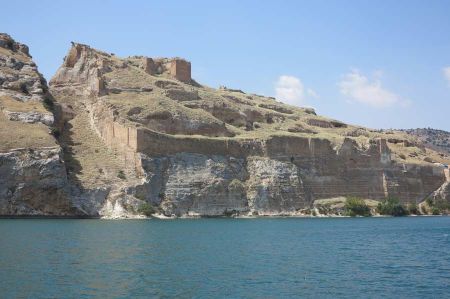The Rum Kalesi / Hromkla near Sanliurfa, considered sacred
- Written by Portal Editor
The myths surrounding the Rum Kalesi Castle in the Yavuzeli district of the Turkish province of Gaziantep reach far back into history. Various epochs of up to 3,000 years are known to date. Archaeologists have only begun to extensively explore the ruins in recent years.
The Rum Kalesi has an almost sacred character among the Christians, as the fortress was used by them to reproduce the Holy Scriptures. In general, the region of Sanliurfa, formerly Edessa, can be seen as the first large area in which Christianity spread.
Naming Rum Kalesi or Rumkale with Roman castle
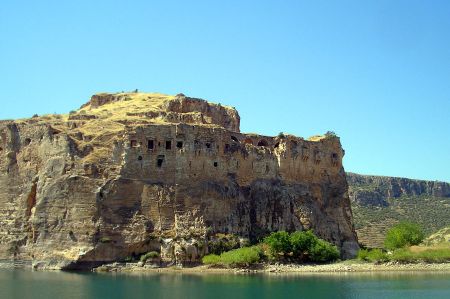 In addition to the historical significance of Rum Kalesi as a fortress, the natural surroundings are also unmistakably beautiful. The oldest part of this fortification comes from the Byzantines. Hence the naming Rum Kalesi or Rumkale with Roman castle.
In addition to the historical significance of Rum Kalesi as a fortress, the natural surroundings are also unmistakably beautiful. The oldest part of this fortification comes from the Byzantines. Hence the naming Rum Kalesi or Rumkale with Roman castle.
As part of the restoration, hiking trails will also be created so that visitors can better see the splendour of the Rum Kalesi. Due to the construction of the Birecik Dam, which flooded some of the lower parts of the fortifications, the castle had become almost inaccessible to visitors and could only be reached by boat.
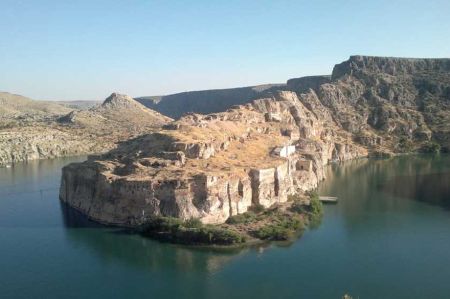 Since the First Crusade, Rumkale / Hromkla has belonged as a "ranculat" to the territory of the Crusader Principality of Edessa. 1151 moved Gregory III. Pahlavuni, the Catholicos of the Armenian Apostolic Church, at the invitation of Beatrice, the widow of Joscelin II of Edessa, from his official residence in Tzvok' to Hromkla. According to the records of the historian Bar Hebraeus, he expelled the castellan Michael there; in truth, however, he seems to have bought the Byzantine castle. As a result, Gregory III built. Pahlawuni expanded the castle into an almost impregnable fortress. In 1179 a council met on the question of the union of the Armenian and Byzantine churches in Hromkla. The participants also included the Catholicos of the Caucasian Albanians and some bishops of Greater Armenia, but not the anti-Union heads of the important monasteries there, Haghpat and Sanahin.
Since the First Crusade, Rumkale / Hromkla has belonged as a "ranculat" to the territory of the Crusader Principality of Edessa. 1151 moved Gregory III. Pahlavuni, the Catholicos of the Armenian Apostolic Church, at the invitation of Beatrice, the widow of Joscelin II of Edessa, from his official residence in Tzvok' to Hromkla. According to the records of the historian Bar Hebraeus, he expelled the castellan Michael there; in truth, however, he seems to have bought the Byzantine castle. As a result, Gregory III built. Pahlawuni expanded the castle into an almost impregnable fortress. In 1179 a council met on the question of the union of the Armenian and Byzantine churches in Hromkla. The participants also included the Catholicos of the Caucasian Albanians and some bishops of Greater Armenia, but not the anti-Union heads of the important monasteries there, Haghpat and Sanahin.
Stephen IV was taken to Egypt
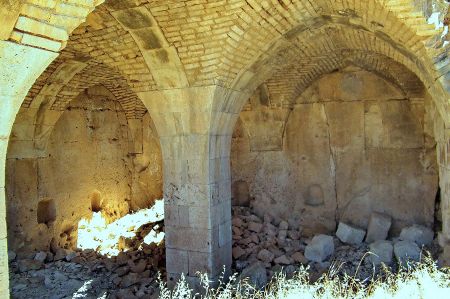 From 1150 to 1292 Rum Kalesi / Hromkla was the official seat of the Armenian Patriarch of Cilicia. Catholicos Nerses IV Schnorhali also resided here. The Patriarch of the Syrian Orthodox Church from the nearby Barsauma Monastery was a frequent guest in Hromkla. Patriarch Ignatius III David (1222-1252) had the entire library of this monastery transferred to Hromkla, including original manuscripts of the patriarch Michael I. d. size († 1199). Having died in Hromkla after a stay of several years, Ignatius David was finally buried there in 1252.
From 1150 to 1292 Rum Kalesi / Hromkla was the official seat of the Armenian Patriarch of Cilicia. Catholicos Nerses IV Schnorhali also resided here. The Patriarch of the Syrian Orthodox Church from the nearby Barsauma Monastery was a frequent guest in Hromkla. Patriarch Ignatius III David (1222-1252) had the entire library of this monastery transferred to Hromkla, including original manuscripts of the patriarch Michael I. d. size († 1199). Having died in Hromkla after a stay of several years, Ignatius David was finally buried there in 1252.
On June 28, 1292, the castle was conquered by the Islamic Mamluks under Sultan Chalil. After Hethum of Korykos, the conquerors captured Catholicos Stephen IV, bishops, Vardapets, priests and many Christians and handed over the bishop's palace and church of Hromkla to former Christian apostates. Stephen IV was taken to Egypt, where he died after a year's imprisonment.
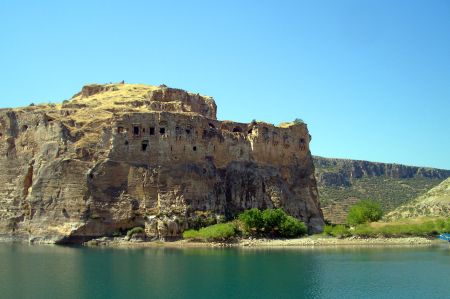 Hromkla remained an important fortress among the Muslims, also briefly a state prison in Ottoman times. In 1832 the fortress was partially destroyed by Ibrahim Pasha and has been empty ever since. With the now planned restoration, for which about 2 years are calculated, the castle on the Euphrates could open up to tourism. Planned costs of the structural measures including investments in the hiking trails are 6.5 million TL. In addition to the Mosaic Museum, which has already opened, another attraction could revitalize tourism in the Sanliurfa region and represent a worthwhile destination for travellers interested in cultural history.
Hromkla remained an important fortress among the Muslims, also briefly a state prison in Ottoman times. In 1832 the fortress was partially destroyed by Ibrahim Pasha and has been empty ever since. With the now planned restoration, for which about 2 years are calculated, the castle on the Euphrates could open up to tourism. Planned costs of the structural measures including investments in the hiking trails are 6.5 million TL. In addition to the Mosaic Museum, which has already opened, another attraction could revitalize tourism in the Sanliurfa region and represent a worthwhile destination for travellers interested in cultural history.
Please read as well:
